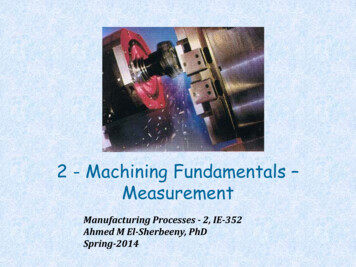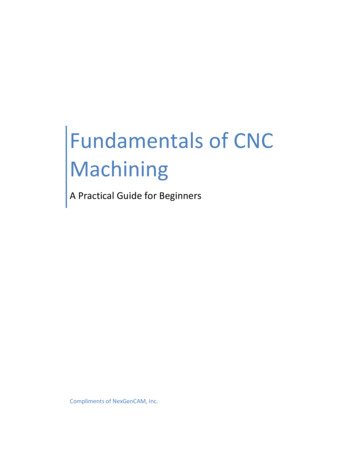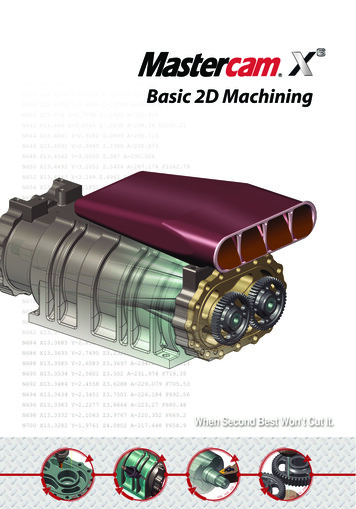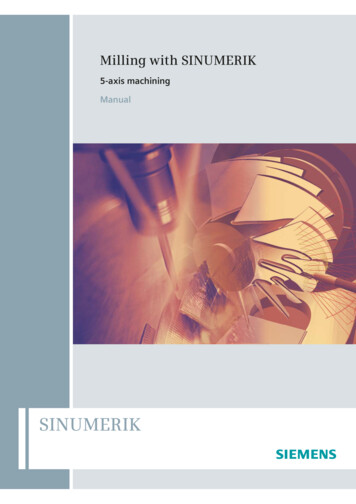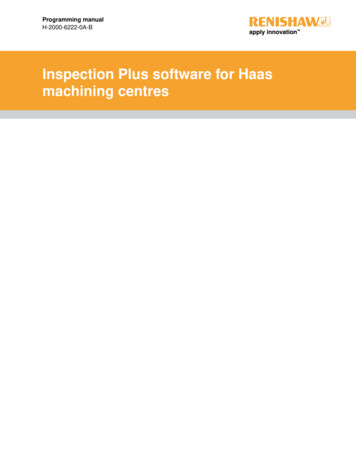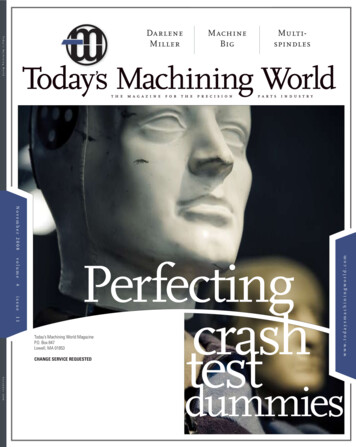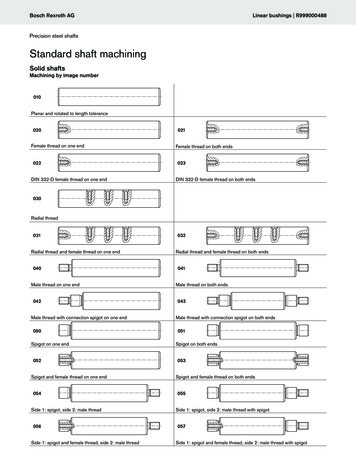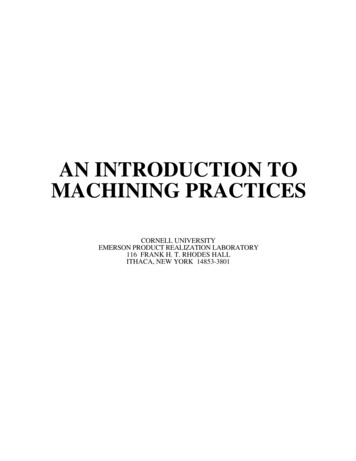
Transcription
AN INTRODUCTION TOMACHINING PRACTICESCORNELL UNIVERSITYEMERSON PRODUCT REALIZATION LABORATORY116 FRANK H. T. RHODES HALLITHACA, NEW YORK 14853-3801
The Emerson LaboratoryWhat is the Emerson Laboratory?Simply stated, it is an area where students, faculty, staff, and all other members of the Cornell communitymay use the available machine tools to facilitate completion of their projects and/or coursework.Mechanical Engineering students use the shop to support the various projects in their curriculum includinglaboratory sessions. Many users fabricate items related to design projects, such as the HEV and FormulaSAE projects within the engineering college, as well as other team projects throughout the University.Staff members fabricate equipment needed by faculty for research projects. Emerson may even be usedfor personal fabrication projects.Where is the Emerson Laboratory?The machine shop (Emerson Manufacturing Teaching Laboratory) is located on the first floor of FrankH.T. Rhodes Hall. When entering the building from the front entrance, turn left after the reception area.The door straight ahead (Room 116) is the shop. Feel free to walk in and look around.Capabilities of the Emerson LaboratoryWhat can be done in the Emerson Laboratory?Anyone who has had the proper training on the available equipment may use the shop for fabrication ofparts made from the various metal alloys. We are not able to fabricate from wood, phenolic, epoxy glass,and other materials that create large amounts of residual dust. Metal alloys are the only permissiblematerials allowed. There are some exceptions to this rule that should be discussed with shop personnel asthe situation arises.The shop keeps a small inventory of tooling, but Emerson does not have all the tooling that might benecessary for all projects. Technical Service Facilities (TSF), located in the basement of Upson Hall, hasa stockroom of tooling available for purchase or use. Tooling may “borrowed”, if it is available, by usingthe log out system they have in place. TSF also stocks some raw materials (i.e. screws, nuts, bolts, etc.)that may need to be purchased for projects.What machines are available in the Emerson Laboratory?The shop currently has a variety of machine tools. In most cases, more than one of each is available.Please be aware of the hours of operation of the lab and the limitations of each machine as explained in thismanual.Here is a list of available equipment:Horizontal Bandsaws (2)Vertical Bandsaw (1)Drill Presses (3)Vertical Milling Machines (2)Horizontal Milling Machine (1)Lathes (9)Belt Sander (1)Disc Sander (1)CNC Milling Machines (2)CNC Lathe (1)Instrons (2) [used for material testing, load frames]Coordinate Measuring Equipment (Metrology Cell)Welders:MIG, TIG, Stick and Oxy-acetleneThere are signs near each machine to explain their operation and safety rules. If theyare unclear, please ask for a clarification!Page 2
Design ConceptsThis section is provided to help plan the activities in the shop during the design stage of a project. Ifmanufacturing issues are considered early in the design, time and frustration during the actual fabricationcan be saved. Plan the design thoroughly with specific sketches and detailed drawings for constructionand machining. The following list of questions is to get you thinking about some important conceptsduring the design process. If you cannot answer all of these questions, do not get frustrated since some ofthem are open ended. The answers will fall into place as experience is gained. Read through this list andfamiliarize yourself with these concepts. Remember, a design that cannot be built is a failure!General design tipsCan the design be made? Will slight modifications make it easier?Is there already something which does what I need?Am I using standard sizes?Will the part have uses other than the intended?Will the part be subjected to harmful environmental conditions?What tradeoffs can I live with in the design?Can it be fabricated?Can it be made in the shop?Where will I get the materials?Which tools will I need to use?How accurate does it have to be? (i.e. what are the tolerances needed?)What are the machining steps required? Is this the minimum number of steps?How long will it take?Ease of machiningIn what order will I perform the machining?What is the easiest material I can work with?What needs to be accurate, and more importantly, what does not?Is this a one of a kind, or will it be duplicated again later?Page 3
The purpose of this manual is to introduce the various hand operated machinery, tools, andassociated tooling available for student use in Emerson Laboratory.Instruction will be basic in nature, and should not be considered a certification course inmachine operation.Specialized instruction may be required at the time of actual machine use, and will beprovided by laboratory personnel as their time permits.CAUTIONIMPROPER USE OF ANY MACHINE TOOLS MAY RESULT IN SEVEREINJURY OR DEATH. MANDATORY ADHERENCE TO ALL SAFETY RULESIS REQUIRED. EXPULSION FROM THE LABORATORY WILL RESULTFROM NON-COMPLIANCE WITH THESE RULES.Page 4
Safety RulesThese rules have been broken down into three general categories:General Shop SafetyPersonal SafetySafety in the Work EnvironmentGeneral Shop Safety1. Radios, CD Players, headphones, etc. are not permitted in the lab.2. No food or drink of any kind is permitted in the shop areas, including the CIM Computer facility.3. All equipment operators and their work will be shown the proper respect by those using this facility.4. All accidents and injuries will be reported to the Shop Supervisor IMMEDIATELY.5. Any transportation of injured individuals is to be done only by qualified personnel.(Cornell Police) for assistance.Call 5-1111Personal Safety1. Proper eye protection will be worn in the machine shop area at all times. Shop users wishing to usetheir personal glasses must document that the lenses and frames are rated for this purpose.2. Proper footwear will be worn at all times. No bare feet, shoes with open toes, slippers, high heels orsandals are permitted.3. Secure all loose clothing, jewelry, neckties, hair, etc. so that it cannot become entangled in theequipment.4. No gloves are to be worn while operating any of the equipment, with the exception of welding gloves.5. Plastic gloves must be worn whenever first aid involving open wounds is being administered toanother. Also, all medical waste will be disposed of in the proper manner.Workplace Safety1. Work areas, benches, and aisles will be kept clear and free of obstructions. Coats and backpacksshould be stored on the coat rack at the front of the lab.2. No equipment will be used for any purpose other than that for which is was specifically designed.3. No equipment is to be left running while either physically or mentally unattended.4. No equipment will be operated without its guards, shields, and safety locks in place and functioning.5. Any oil or grease spilled on the floor will be cleaned up IMMEDIATELY and disposed of in the propermanner.6. No keys will be left in the chucks of the lathes or drill presses.7. Only one operator per machine is allowed. Special jobs involving more than one operator require thepermission of the Shop Supervisor. Exception to this rule is only during instructional purpose and/ortraining sessions.These are basic safety rules which apply to the lab in general. Each machine tool and piece of testequipment has its own additional safety rules and considerations. It is the operator's responsibility to befamiliar with these before using any equipment. Training on a particular piece of equipment will be doneat the convenience of the laboratory staff.Page 5
Operating Procedures1. No non-metallic materials will be machined without prior approval.2. Any damaged, broken, or unsafe equipment will be reported to lab personnel IMMEDIATELY.3. Users are responsible for knowing the correct operating procedures and any associated safety rules forthe equipment they are using. Shop personnel are there to answer questions or show you how to getanswers.4. All tools and materials will be returned to their correct storage area IMMEDIATELY upon completionof work.5. All chips and scraps are to be cleaned from machines, floors, and bench tops IMMEDIATELY uponcompletion of work.6. Work is not to be left set up in machines for more than one (1) hour without prior approval. Work leftpast this time may be removed to make equipment available to others.7. Shop hours are 8:00 AM to 5:00 PM., with clean up starting promptly at 4:30 PM. Changes to thesehours will be posted on the door in advance. It is the users’ responsibility to note them and planaccordingly.8. There is a clipboard and pen next to each machine - sign in each time you use the machine with yourname and phone number.Clean-Up ProceduresThis is a general guideline of the clean-up procedures for the Emerson shop1. Make sure to sweep up the chips on the floor and on the machine. This includes all parts of themachine (i.e. table, tool holder, slots, collets, etc.).2. Clean up any excess oil that is on the machine or the floor. This includes any oil which may havegotten onto the vise, tabletop, etc.3. Put away all the hand tools that were used in their appropriate spots.Page 6
TerminologyArbor: A device used to hold cutting tools on a milling machine. It is used for cutters rather thanendmills.Backlash: The “slop” or discrepancy between actual distance and measured distance when using thetable’s travel handles on a lathe or a milling machine. Backlash occurs when the direction of rotationof the handle is changed: the handle has to be rotated a little before it “catches” and moves the table.Center Drill: A short stubby drill used to start holes. This drill is double ended, where either end can beused. Since it is short and stubby, it does not deflect upon contact with the workpiece and can beused to create an accurately positioned pilot hole.Center Punch: A metal device that is gently hit with a hammer to create a dimple that helps to guide thedrill bit to the proper location. Without this dimple, the drill bit can “walk” away from the desiredlocation.Chips: The pieces of material that are removed from a workpiece through machining; shavings.Chuck: A device used to hold items. A drill chuck is used to hold a drill bit to the spindles on a drillpress or to the tailstock on a lathe. A different kind of chuck is used to hold a workpiece to theheadstock on a lathe.Chuck Key: A wrench used to tighten the jaws of a chuck around whatever the chuck is holding, or toloosen the jaws.Collet: A device used to hold an endmill inside the spindle on a milling machine.Dead Center: A device that is placed into the tailstock of a lathe in order to hold a long workpiece. ItDOES NOT rotate with the workpiece whereas the live center does rotate with the workpiece.Drill Bit Gauge: A device used to measure the size of a drill bit if the size is not visible on the shank. Adrill bit gauge has many different sized holes, all labeled a different size.Drilling: Making a hole in a workpiece by pushing a rotating cutting tool into a stationary workpiece.Drilling is performed on a drill press or a milling machine.Edge Finder: Two concentric cylinders that are spring loaded together. It can be placed in a collet of amilling machine.Endmill: A cutting tool used on a milling machine to cut the side of a workpiece.External Operations: Procedures followed to machine the outside surface of a workpiece.Facing: An external operation performed on a lathe which wears down the end surface to bring aworkpiece to a desired length and/or to make the end surface plane and square. The work is rotatedagainst a fixed cutting tool, i.e. such as making a cylinder shorter and giving it a finished endsurface.Feed Lever: A handle used to lower the spindle to the workpiece on a drill press or milling machine.Headstock: The part on a lathe that holds the chuck which holds the workpiece.Internal Operations: Procedures followed to machine the inside surface of a workpiece.Live Center: A device placed in the tailstock of a lathe to hold a workpiece that may be long. Thiscenter rotates with the workpiece whereas a dead center does not rotate with the workpiece.Page 7
Milling: Any operation performed on a milling machine using a rotating cutter or endmill to removematerial from a workpiece.Pitch: The number of teeth per inch on a blade.Shank: The smooth part of a drill bit that is held by the drill chuck. The drill bit size is stamped on theshank.Spindle: The part of a drill press or milling machine which is spun by the motor, it holds a chuck, collet,or arbor.Tailstock: The part on a lathe that holds a drill chuck or holds the outer end of a long workpiece. It isadjustable to accommodate different lengths.Tap: A device that looks similar to a screw only it has straight flutes cut into the sides to allow the chipsto be expelled. This device threads holes that have been drilled.Turning: An external operation performed on a lathe which shapes the side surface of a rotatingworkpiece with a cutting tool, i.e. such as making a cylinder with a smaller diameter.Page 8
Section One:HORIZONTAL BANDSAWVERTICAL BANDSAWThese machine tools are not only versatile in their configurations, but in their functions as well. Thoughthey are all used for cutting raw stock of various materials into smaller or more machine adaptable blanks,each type has a specific purpose and use. The name “bandsaw” comes from the serrated sawblade whichforms a continuous loop around two pulleys, one pulley is driven by a motor, the other is idle.HORIZONTAL BANDSAWThe horizontal bandsaw has an automatic feeding head, so that when it is properly configured, the cuttingoperation is carried out automatically. The following guides will help in the operation of this type of saw.1. Assure the blade is the proper one for the material being cut. Blades vary in pitch and styl
an introduction to machining practices cornell university emerson product realization laboratory 116 frank h. t. rhodes hall ithaca, new york 14853-3801

